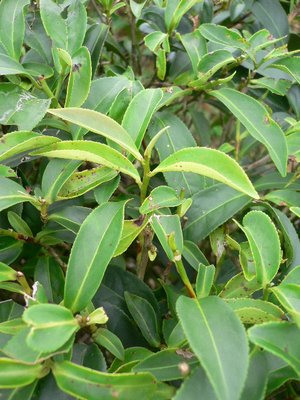 Let's first look at the tea leaves to understand what's new about this tea. We can first say that it is based on luanze (Qingxin) Oolong, the traditional tea tree of Dong Ding. Second, this is a summer tea, a season that is known for producing less fragrant, more bitter teas. Third, we can see that the leaves are bitten by insects. Master Zhang is not using any pesticides on this field on purpose. He's actually counting on those bites to jumpstart the fermentation of the leaves and create a sweet & sour pineapple taste.
Let's first look at the tea leaves to understand what's new about this tea. We can first say that it is based on luanze (Qingxin) Oolong, the traditional tea tree of Dong Ding. Second, this is a summer tea, a season that is known for producing less fragrant, more bitter teas. Third, we can see that the leaves are bitten by insects. Master Zhang is not using any pesticides on this field on purpose. He's actually counting on those bites to jumpstart the fermentation of the leaves and create a sweet & sour pineapple taste.You probably have guessed by now where his inspiration is coming from: Oriental Beauty (also called Bai Hao Oolong). That's the reason why he named this tea Concubine tea in reference to Oriental Beauty.
One of the differences with Oriental Beauty, besides location, is that the Guei Fei Cha is processed into a ball like a traditional Dong Ding Oolong.
 Master Zhang is also then able to make variations on the taste of this tea using roasting. In the middle, you can see a roasted summer 2005 Guei Fei. It displays a browner color and sweeter taste than the fresh summer 2006 Guei Fei on the right. This tea was made just two days before I arrived! Difficult to taste much fresher tea!! Nevertheless, I preferred the roasted 2005 Guei Fei.
Master Zhang is also then able to make variations on the taste of this tea using roasting. In the middle, you can see a roasted summer 2005 Guei Fei. It displays a browner color and sweeter taste than the fresh summer 2006 Guei Fei on the right. This tea was made just two days before I arrived! Difficult to taste much fresher tea!! Nevertheless, I preferred the roasted 2005 Guei Fei.According to my tasting, Guei Fei Cha has not yet reached the quality level of the best Bai Hao I have in my selection (or I should say had, since I'm currently out of stock on Bai Hao). This explains the price difference. For me, it seems that this tea is better well roasted than just strongly oxidized. But maybe Master Zhang needs a little more time to experiment with it to take it to a higher quality level. Anyway, I think that this tea can become a good answer to the growing demand of good pesticide free, biologically grown oolong tea.

Taken from http://teamasters.blogspot.com/
No comments:
Post a Comment